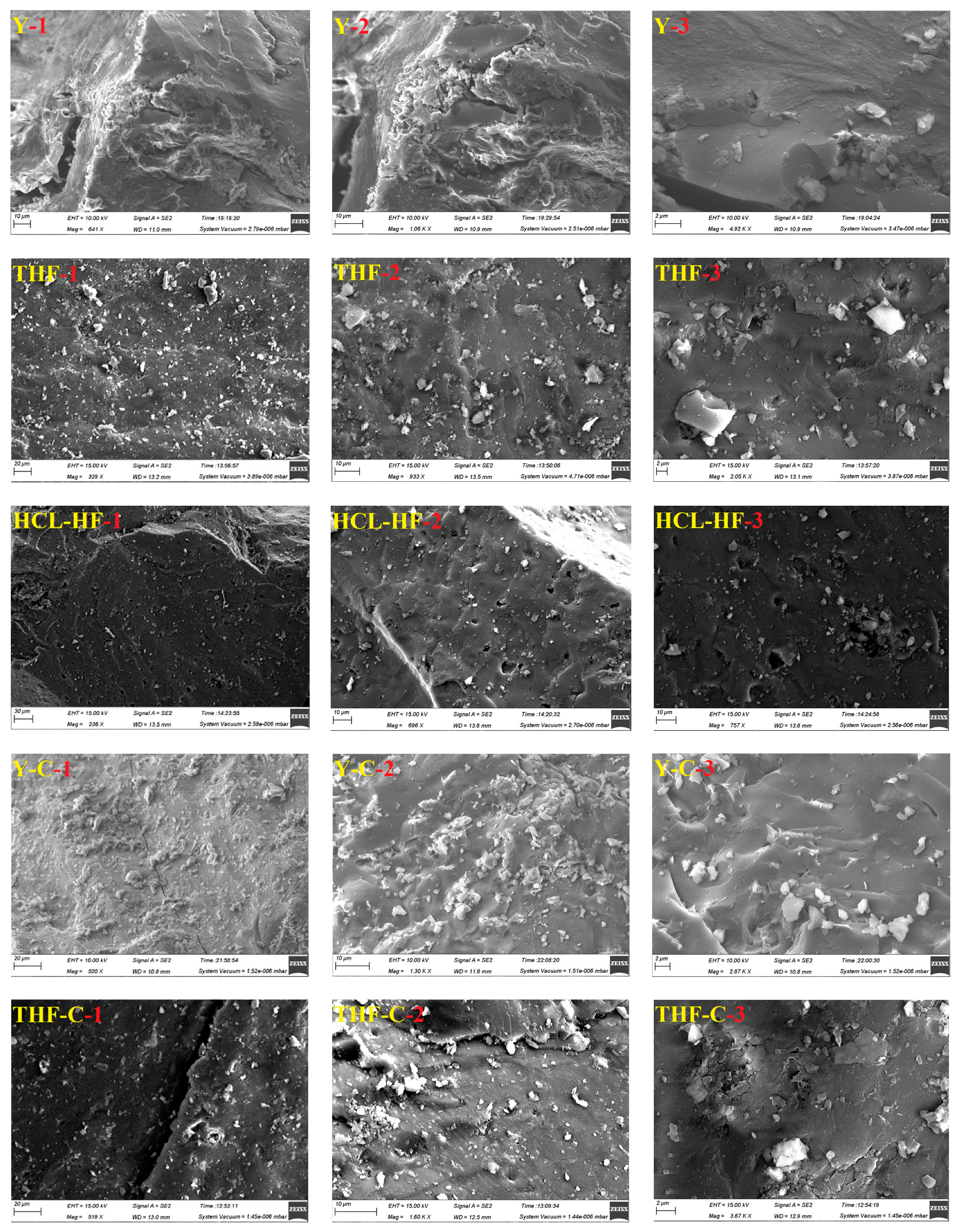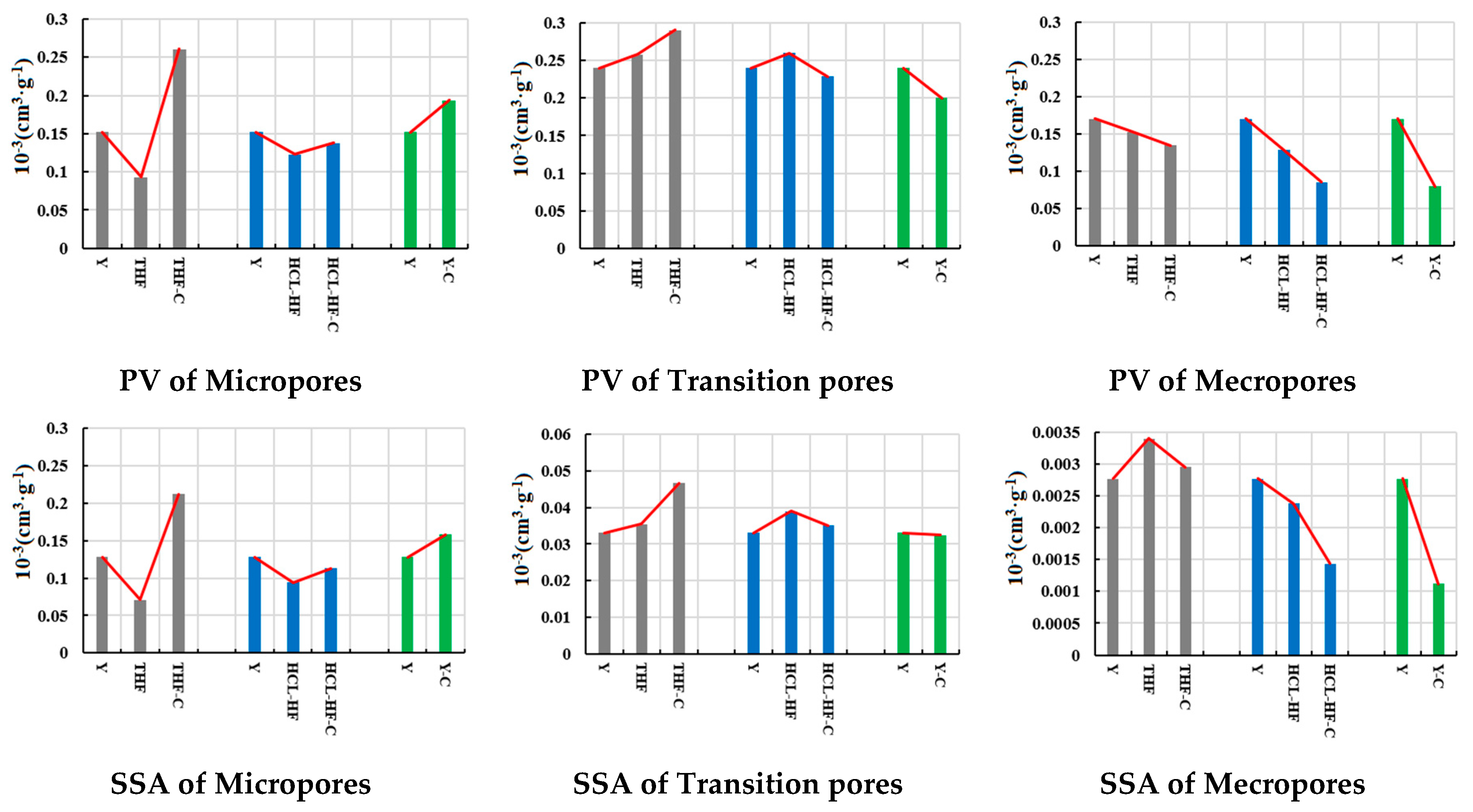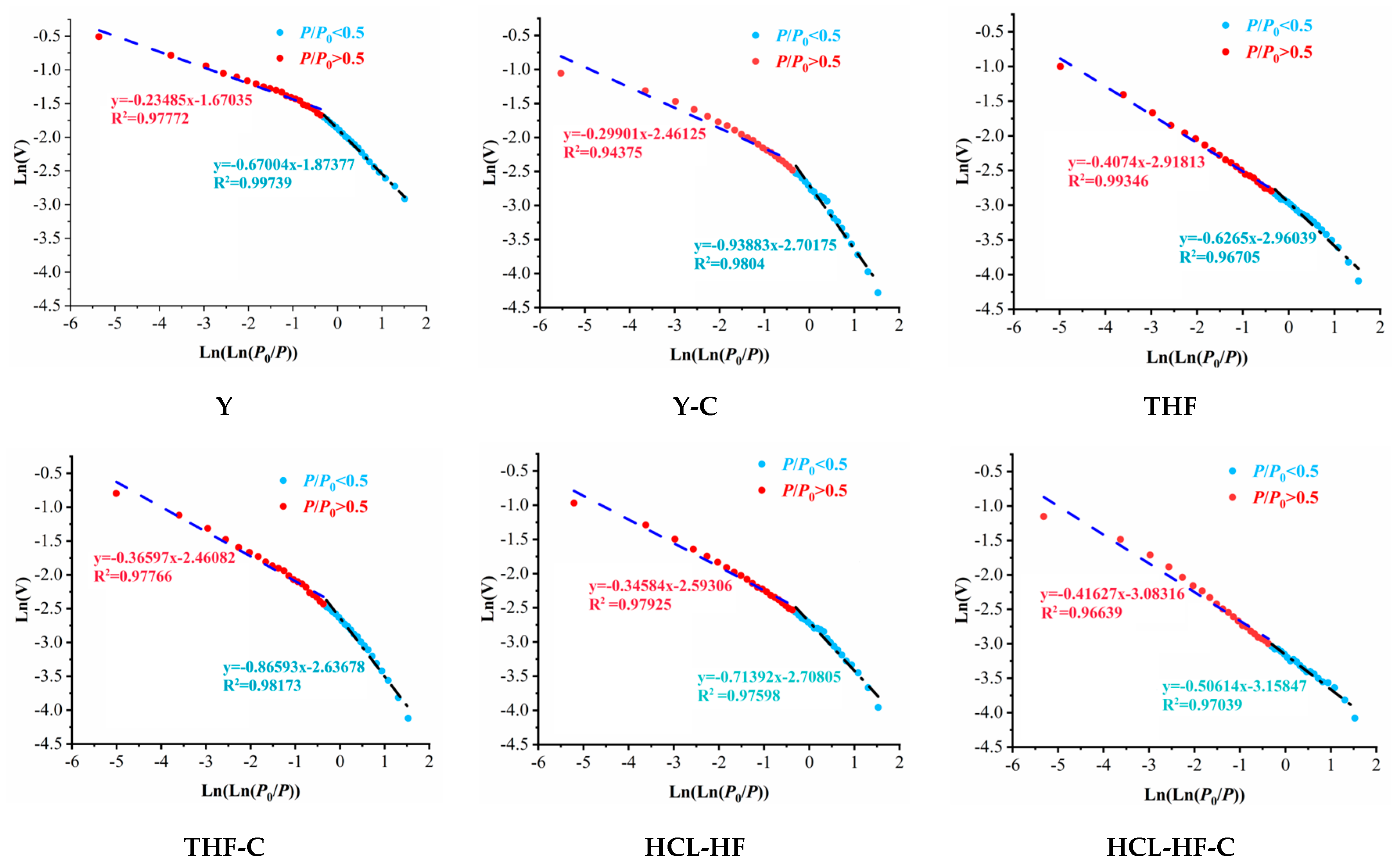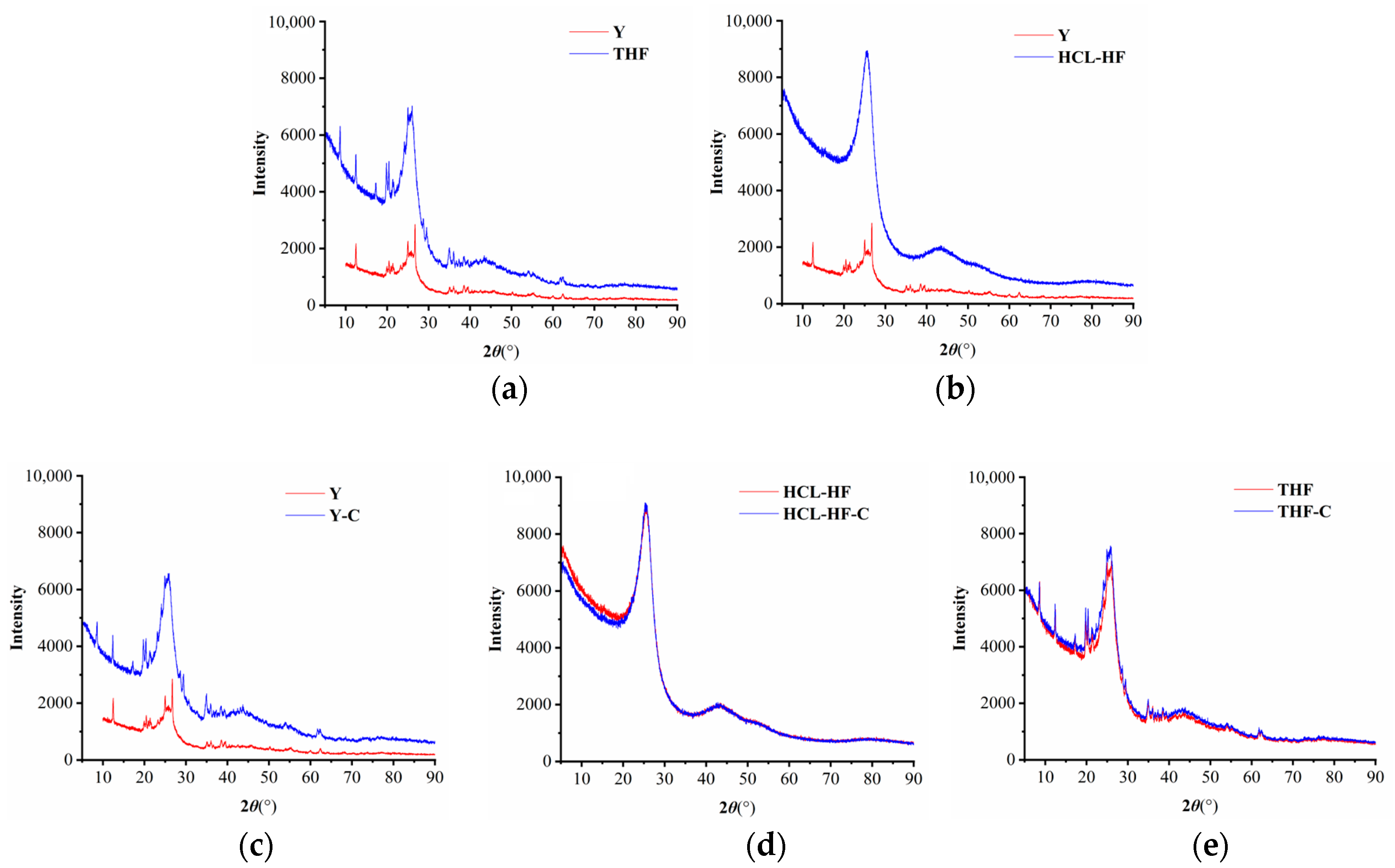Changes in Pore Structure and Fractal Characteristics of Solvents Pretreated High-Rank Coal under Supercritical CO2
Abstract
:1. Introduction
2. Experimental
2.1. Coal Samples
2.2. Solvent Pretreatment
2.3. SC-CO2 Extraction Experiments
2.4. LTGA-N2 Tests
2.5. X-ray Diffraction Experiment
3. Results and Discussion
3.1. Surface Morphology of Coal Samples
3.2. Pore Structure Characteristics
3.2.1. N2 Adsorption Isotherms of Coal
3.2.2. Pore Structure Parameters
3.2.3. Pore Size Distribution in Coal
3.2.4. Fractal Characteristics of Nanopores
3.3. Microcrystalline Structure
3.4. Mechanism of Solvent and SC-CO2 Extraction on the Pore Structure of Coal
3.4.1. Acid Solvent
SiO2 (quartz) + 6HF = H2SiF6 + 2H2O
CaCO3 (calcite) + HCl = CaCl2 + CO2↑ + H2O
3.4.2. THF Solvent
3.4.3. SC-CO2
CaCO3 + 2H+ = Ca2+ + CO2↑ + H2O
Al2O3·2SiO2·2H2O (kaolinite) + 6H+ = 2Al3+ + 2SiO2 + 5H2O
3.5. Relationship between Fractal Dimension and Pore Structure Parameters and Implications for Geological Sequestration of CO2
4. Conclusions
- (1)
- Raw coals treated with different solvents and SC-CO2 shows an increase in average pore size, while the total PV decreased and pore connectivity deteriorated. Samples THF and HCL-HF show improved pore connectivity with secondary treatment of SC-CO2, but the total PV was continuously decreased.
- (2)
- Solvents treatment and SC-CO2 extraction mainly act on the microporous fraction. After solvents pretreatment, the changes in the PSD curves of the coal samples are mainly manifested in the reduction of number of micropores after solvents pretreatment, especially in the micropores around 3–4 nm. There is a small increase in the number of micropores appeared in the samples Y-C and HCL-HF-C, with the pore size mainly concentrated around 4 nm, while the pores number of the sample THF-C mainly shows an increase in the range of 3–16 nm.
- (3)
- Generally, solvent pretreatment and SC-CO2 extraction help to simplify pore structure. However, for sample HCL-HF, the pore becomes more complicated by SC-CO2 secondary extraction (HCL-HF-C).
- (4)
- There is no obvious linear or nonlinear relationship between PV, SSA and fractal dimension. Pore connectivity is influenced by both fractal dimension and time to some extent. In the short term, the larger the fractal dimension, the more unfavorable it is for CO2 flow. Then, the effect of CO2 in enlarging the pores plays a dominant role with increasing time and the pore fractal dimension becomes progressively less useful in assessing pore connectivity.
Author Contributions
Funding
Data Availability Statement
Acknowledgments
Conflicts of Interest
References
- Haszeldine, R.S. Carbon capture and storage: How green can black be? Science 2009, 325, 1647–1652. [Google Scholar] [CrossRef] [PubMed]
- Ma, T.; Rutqvist, J.; Oldenburg, C.M.; Liu, W. Coupled thermal-hydrological-mechanical modeling of CO2 enhanced coalbed methane recovery. Int. J. Coal Geol. 2017, 179, 81–91. [Google Scholar] [CrossRef]
- Agrawal, R.; Kumar, Y.; Sarkhel, R.; Damdhar, M.S.; Sangwai, J.S. Enhancing the CO2 sequestration potential in subsea terrain by hydrate formation from liquid CO2. Energy Fuels 2023, 37, 14961–14976. [Google Scholar] [CrossRef]
- Ni, S.M.; Lv, W.F.; Ji, Z.M.; Wang, K.; Andersen, P.O. CO2 mineralized sequestration and assistance by microorganisms in reservoirs: Development and outlook. Energies 2023, 16, 7571. [Google Scholar] [CrossRef]
- Fan, C.J.; Yang, L.; Sun, H.; Luo, M.K.; Zhou, L.J.; Yang, Z.H.; Li, S. Recent advances and perspectives of CO2-Enhanced coalbed methane: Experimental, modeling, and technological development. Energy Fuels 2023, 37, 3371–3412. [Google Scholar] [CrossRef]
- Radovic, L.; Menon, V.; Leon, C.L.Y.; Kyotani, T.; Danner, R.P.; Anderson, S.; Hatcher, P.G. On the porous structure of coals: Evidence for an interconnected but constricted micropore system and implications for coalbed methane recovery. Adsorption 1997, 3, 221–232. [Google Scholar] [CrossRef]
- Yu, J.K. Study on the Relationship between the Microstructure of Tectonic Coal and Gas Adsorption; Henan Polytechnic University: Jiaozuo, China, 2018. [Google Scholar]
- Zhao, J.; Xu, H.; Tang, D.; Mathews, J.P.; Li, S.; Tao, S. A comparative evaluation of coal specific surface area by CO2 and N2 adsorption and its influence on CH4 adsorption capacity at different pore sizes. Fuel 2016, 183, 420–431. [Google Scholar] [CrossRef]
- Zhang, X.D.; Zhang, S.; Li, X.Z.; Heng, S. Dynamic evolution of nanoscale pores of different rank coals under solvent extraction. J. Nanosci. Nanotechnol. 2021, 21, 450–459. [Google Scholar] [CrossRef]
- Wang, F.F.; Zhang, X.D.; Wu, C.F.; Zhang, S.; Wang, K. Mechanism of solvent extraction-induced changes to nanoscale pores of coal before and after acidification. Fuel 2023, 344, 128027. [Google Scholar] [CrossRef]
- Turner, L.G.; Steel, K.M. A study into the effect of cleat demineralisation by hydrochloric acid on the permeability of coal. J. Nat. Gas. Sci. Eng. 2016, 36, 931–942. [Google Scholar] [CrossRef]
- Wang, J.H.; Mei, M.H.; Liu, J.; Wang, H.J. Optimization of acid fracturing mechanism and construction procedure for increasing production in coalbed methane wells. Contem. Chem. Ind. 2020, 49, 1892–1895. [Google Scholar]
- Du, Y.; Fu, C.Q.; Pan, Z.J.; Sang, S.X.; Wang, W.F.; Liu, S.Q.; Zhao, Y.C.; Zhang, J.Y. Geochemistry effects of supercritical CO2 and H2O on the mesopore and macropore structures of high-rank coal from the Qinshui basin, China. Int. J. Coal Geol. 2020, 223, 103467. [Google Scholar] [CrossRef]
- Feng, T.T.; Sun, Y.; Wang, X.J.; Xu, J.L.; Wang, F.C. Structure and gasification characteristics of coal extracted by supercritical CO2/NMP mixed solvent. J. East China Univ. Sci. Technol. (Nat. Sci. Ed.) 2013, 39, 131–137. [Google Scholar]
- Mohsen, S.M.; David, W.A.; Abbas, E.Z. Experimental investigations on the effect of CO2 on mechanics of coal. Int. J. Coal. Geol. 2015, 399, 134–144. [Google Scholar]
- Zhang, S.; Wang, Z.M.; Zhang, X.D.; Chen, F.J.; Ping, X.D.; Sun, Z.Y. Experimental study on physicochemical structure of different rank coals under acid solvent treatments and its effects on heat of gas adsorption. J. Pet. Sci. Eng. 2022, 211, 110191. [Google Scholar] [CrossRef]
- Neupane, B.; Ju, Y.W.; Huang, C. Micro/Nano-Pore Structure Characterization of Western and Central Nepal Coals Using Scanning Electron Microscopy and Gas Adsorption. J. Nanosci. Nanotechnol. 2017, 17, 6836–6842. [Google Scholar] [CrossRef]
- Nie, B.S.; Liu, X.F.; Yang, L.L.; Meng, J.Q.; Li, X.C. Pore structure characterization of different rank coals using gas adsorption and scanning electron microscopy. Fuel 2015, 158, 908–917. [Google Scholar] [CrossRef]
- Li, Y.; Song, D.; Liu, S.; Ji, X.; Hao, H. Evaluation of pore properties in coal through compressibility correction based on mercury intrusion porosimetry: A practical approach. Fuel 2021, 291, 120130. [Google Scholar] [CrossRef]
- Zhao, S.; Chen, X.; Li, X.; Qi, L.; Zhang, G. Experimental analysis of the effect of temperature on coal pore structure transformation. Fuel 2021, 305, 121613. [Google Scholar] [CrossRef]
- Okolo, G.N.; Everson, R.C.; Neomagus, H.W.; Roberts, M.J.; Sakurovs, R. Comparing the porosity and surface areas of coal as measured by gas adsorption, mercury intrusion and SAXS techniques. Fuel 2015, 141, 293–304. [Google Scholar] [CrossRef]
- Zhao, S.P.; Ding, R.; Tian, W.G.; Ye, J.C. Multiscale Fine Characterization of a Coal Pore–Fracture System Based on SEM, CT, and NMR in the Jingbian Block, Ordos Basin. Energies 2023, 16, 5315. [Google Scholar] [CrossRef]
- Yao, Y.; Liu, D.; Xie, S. Quantitative characterization of methane adsorption on coal using a low-field NMR relaxation method. Int. J. Coal Geol. 2014, 131, 32–40. [Google Scholar] [CrossRef]
- Li, Y.; Yang, J.H.; Pan, Z.J.; Tong, W.S. Nanoscale pore structure and mechanical property analysis of coal: An insight combining AFM and SEM images. Fuel 2020, 260, 116352. [Google Scholar] [CrossRef]
- Xiong, Q.R.; Li, K.; Yang, D.S.; Yu, H.D.; Pan, Z.J.; Song, Y. Characterizing coal pore space by gas adsorption, mercury intrusion, FIB–SEM and μ-CT. Environ. Earth. Sci. 2020, 79, 209. [Google Scholar] [CrossRef]
- Liu, S.Q.; Sang, S.X.; Wang, G.; Ma, J.S.; Wang, X.; Wang, W.F.; Du, Y.; Wang, T. FIB-SEM and X-ray CT characterization of interconnected pores in high rank coal formed from regional metamorphism. J. Pet. Sci. Eng. 2017, 148, 21–31. [Google Scholar] [CrossRef]
- Jing, D.; Meng, X.; Ge, S.; Zhang, T.; Ma, M.; Tong, L. Reconstruction and seepage simulation of a coal pore-fracture network based on CT technology. PLoS ONE 2021, 16, e0252277. [Google Scholar] [CrossRef]
- Giffin, S.; Littke, R.; Klaver, J.; Urai, J.L. Application of BIB–SEM technology to characterize macropore morphology in coal. Int. J. Coal Geol. 2013, 114, 85–95. [Google Scholar] [CrossRef]
- Zhou, S.D.; Liu, D.M.; Cai, Y.D.; Yao, Y.B.; Li, Z.T. 3D characterization and quantitative evaluation of pore-fracture networks of two Chinese coals using FIB-SEM tomography. Int. J. Coal Geol. 2017, 174, 41–54. [Google Scholar] [CrossRef]
- Harris, L.A.; Yust, C.S. Transmission electron microscope observations of porosity in coal. Fuel 1976, 55, 233–236. [Google Scholar] [CrossRef]
- Ye, J.; Tao, S.; Zhao, S.; Li, S.; Chen, S.; Cui, Y. Characteristics of methane adsorption/desorption heat and energy with respect to coal rank. J. Nat. Gas Sci. Eng. 2022, 99, 104445. [Google Scholar] [CrossRef]
- Liu, S.; Ma, J.; Sang, S.; Wang, T.; Du, Y.; Fang, H. The effects of supercritical CO2 on mesopore and macropore structure in bituminous and anthracite coal. Fuel 2018, 223, 32–43. [Google Scholar] [CrossRef]
- Li, Z.B.; Ren, T.; Li, X.C.; Qiao, M.; Yang, X.H.; Tan, L.H.; Nie, B.S. Multi-scale pore fractal characteristics of differently ranked coal and its impact on gas adsorption. Int. J. Min. Sci. Technol. 2023, 33, 389–401. [Google Scholar] [CrossRef]
- Ye, Z.N.; Hou, E.K.; Duan, Z.H.; Wen, Q.; Huang, M.T.; He, D. Fractal characteristics of pores and microfractures of coals with different structure and their effect on permeability. Coal Geol. Explor. 2019, 47, 70–78. [Google Scholar]
- Cai, Y.D.; Liu, D.M.; Pan, Z.J.; Che, Y.; Liu, Z.H. Investigating the effects of seepage-pores and fractures on coal permeability by fractal analysis. Transp. Porous Media 2016, 111, 479–497. [Google Scholar] [CrossRef]
- Liu, X.F.; Nie, B.S. Fractal characteristics of coal samples utilizing image analysis and gas adsorption. Fuel 2016, 182, 314–322. [Google Scholar] [CrossRef]
- Yao, Y.B.; Liu, D.M.; Tang, D.Z.; Tang, S.H.; Huang, W.H. Fractal characterization of adsorption-pores of coals from North China: An investigation on CH4 adsorption capacity of coals. Int. J. Coal Geol. 2008, 73, 27–42. [Google Scholar] [CrossRef]
- Wang, F.; Cheng, Y.P.; Lu, S.Q.; Jin, K.; Zhao, W. Influence of coalification on the pore characteristics of middle high rank coal. Energy Fuels 2014, 28, 5729–5736. [Google Scholar] [CrossRef]
- Wang, F.F.; Zhang, X.D.; Wu, C.F.; Zhang, S.; Wang, K. Mechanism of supercritical CO2 on the chemical structure and composition of high-rank coals with different damage degrees. Fuel 2023, 344, 128027. [Google Scholar] [CrossRef]
- Clarkson, C.; Wood, J.; Burgis, S. Nanopore-structure analysis and permeability predictions for a tight gas siltstone reservoir by use of low-pressure adsorption and mercury-intrusion techniques. SPE Reservoir Eval. Eng. 2012, 15, 648–661. [Google Scholar] [CrossRef]
- Gregg, S.J.; Sing, K.S.W. Adsorption, Surface Area and Porosity, 2nd ed.; Academic Press: New York, NY, USA, 1982. [Google Scholar]
- Shao, L.Y.; Li, J.X.; Wang, S.; Hou, H.H.; Li, J.A.; Zhu, M.Y. Pore structures and fractal characteristics of liquid nitrogen adsorption pores in lignite in the Hailar Basin. Nat. Gas Ind. 2020, 40, 15–25. [Google Scholar]
- Xie, W.D.; Wang, M.; Wang, H.; Duan, H.Y. Multi-scale fractal characteristics of pores in transitional shale gas reservoir. Nat. Gas Geosci. 2022, 33, 451–460. [Google Scholar]
- Qi, H.; Ma, J.; Wong, P. Adsorption isotherms of fractal surfaces. Colloid Surf. A 2002, 206, 401–407. [Google Scholar] [CrossRef]
- Li, Z.W.; Hao, Z.Y.; Pang, Y.; Gao, Y. Fractal dimensions of coal and their influence on methane adsorption. J. China Coal. Soc. 2015, 40, 863–869. [Google Scholar]
- Wang, M.; Xue, H.T.; Tian, S.S.; Wilkins, R.W.T.; Wang, Z.W. Fractal characteristics of Upper Cretaceous lacustrine shale from the Songliao Basin, NE China. Mar. Petrol. Geol. 2015, 67, 144–153. [Google Scholar] [CrossRef]
- Zou, J.P.; Chen, W.Z.; Yang, D.S.; Yuan, J.Q.; Jiao, Y.Y. Fractal characteristics of the anisotropic microstructure and pore distribution of low-rank coal. AAPG Bull. 2019, 103, 1297–1319. [Google Scholar] [CrossRef]
- Xu, Q.; Liu, R.; Yang, H. Effect of acid and alkali solutions on micro-components of coal. J. Mol. Liq. 2021, 329, 115518. [Google Scholar] [CrossRef]
- Hu, B.; Zhang, C.; Zhang, X. The effects of hydrochloric acid pretreatment on different types of clay minerals. Minerals 2022, 12, 1167. [Google Scholar] [CrossRef]
- Yu, Y.; Cheng, G.; Ma, L.; Huang, G.; Wu, L.; Xu, H. Effect of agitation on the interaction of coal and kaolinite in flotation. Powder Technol. 2017, 313, 122–128. [Google Scholar] [CrossRef]
- Chen, Q.; Cao, T.; Xiong, Y.; Wang, C.; Lin, Z.; Chen, Z.; Xu, S.; Xu, Z. Understanding interactions between clay and model coal surfaces in electrolyte solutions by a quartz crystal microbalance with dissipation study. Energy Fuels 2018, 32, 233–240. [Google Scholar] [CrossRef]
- Zhou, L.S.; Du, J.F.; Guo, P.; Wang, Z.H. Influence of supercritical CO2 on the physical property of unconsolidated sandstone reservoir. Oilfield Chem. 2015, 32, 217–222. [Google Scholar]








| Coal Samples | Ultimate Analysis (%) | Proximate Analysis (%) | ||||||
|---|---|---|---|---|---|---|---|---|
| C | H | O | N | Mad | Aad | Vdaf | FCdaf | |
| Y | 74.02 | 3.28 | 21.61 | 0.84 | 1.14 | 25.53 | 12.03 | 61.3 |
| HCl-HF | 86.31 | 3.59 | 8.43 | 1.39 | 1.73 | 0.89 | 12.91 | 84.47 |
| THF | 73.93 | 3.70 | 20.36 | 1.78 | 0.18 | 9.46 | 12.46 | 77.90 |
| Y-C | 79.21 | 3.51 | 15.63 | 1.45 | 1.04 | 8.80 | 11.80 | 78.36 |
| HCl-HF-C | 84.52 | 3.80 | 9.38 | 1.94 | 0.88 | 1.06 | 34.97 | 63.09 |
| THF-C | 68.43 | 3.33 | 26.57 | 1.43 | 0.09 | 9.17 | 12.28 | 78.46 |
| Samples | Average Pore Size (nm) | PV in Different Pore Sizes/10−3(cm3·g−1) | SSA in Different Pore Sizes/(cm2·g−1) | ||||||
|---|---|---|---|---|---|---|---|---|---|
| <10 nm | 10–100 nm | >100 nm | PV in Total | <10 nm | 10–100 nm | >100 nm | SSA in Total | ||
| Y | 8.309 | 0.15201 | 0.23939 | 0.17026 | 0.933 | 0.12791 | 0.03312 | 0.00277 | 0.164 |
| Y-C | 10.37 | 0.19341 | 0.20006 | 0.07969 | 0.5392 | 0.1584 | 0.0325 | 0.00112 | 0.192 |
| THF | 15.363 | 0.092858 | 0.257832 | 0.15273 | 0.5691 | 0.070902 | 0.035498 | 0.0034 | 0.11 |
| THF-C | 13.187 | 0.26068 | 0.28962 | 0.13445 | 0.6992 | 0.21184 | 0.04657 | 0.00295 | 0.261 |
| HCL-HF | 11.63 | 0.12256 | 0.25956 | 0.12787 | 0.5885 | 0.094377 | 0.038993 | 0.00238 | 0.136 |
| HCL-HF-C | 16.099 | 0.13745 | 0.22841 | 0.08515 | 0.4892 | 0.1133 | 0.03508 | 0.00143 | 0.15 |
| Samples | Diameter < 4 nm | Diameter > 4 nm | ||||
|---|---|---|---|---|---|---|
| K2 | D2 | R2 | K1 | D1 | R2 | |
| Y | −0.31876 | 2.68124 | 0.99739 | −0.12559 | 2.87441 | 0.97772 |
| Y-C | −0.85823 | 2.14177 | 0.9804 | −0.19485 | 2.80515 | 0.94375 |
| THF | −0.67529 | 2.32471 | 0.96705 | −0.31224 | 2.68776 | 0.99346 |
| THF-C | −0.90602 | 2.09398 | 0.98173 | −0.25947 | 2.74053 | 0.97766 |
| HCL-HF | −0.76954 | 2.23046 | 0.97598 | −0.27161 | 2.72839 | 0.97925 |
| HCL-HF-C | −0.65395 | 2.34605 | 0.97039 | −0.256 | 2.744 | 0.96639 |
| Samples | PV in Different Pore Sizes/×10−3(cm3·g−1) | SSA in Different Pore Sizes/(cm2·g−1) | ||
|---|---|---|---|---|
| 0–4 nm | 4–10 nm | 0–4 nm | 4–10 nm | |
| Y | 0.065999 | 0.086011 | 0.073035 | 0.054875 |
| Y-C | 0.053502 | 0.139908 | 0.058709 | 0.099691 |
| THF | 0.022408 | 0.07045 | 0.025439 | 0.045463 |
| THF-C | 0.092686 | 0.167994 | 0.099979 | 0.111861 |
| HCL-HF | 0.032872 | 0.089688 | 0.036765 | 0.057612 |
| HCL-HF-C | 0.042275 | 0.095175 | 0.045242 | 0.068058 |
Disclaimer/Publisher’s Note: The statements, opinions and data contained in all publications are solely those of the individual author(s) and contributor(s) and not of MDPI and/or the editor(s). MDPI and/or the editor(s) disclaim responsibility for any injury to people or property resulting from any ideas, methods, instructions or products referred to in the content. |
© 2024 by the authors. Licensee MDPI, Basel, Switzerland. This article is an open access article distributed under the terms and conditions of the Creative Commons Attribution (CC BY) license (https://creativecommons.org/licenses/by/4.0/).
Share and Cite
Li, Y.; Zhang, X.; Sun, Y.; Wang, Z.; Zhang, S.; Li, B. Changes in Pore Structure and Fractal Characteristics of Solvents Pretreated High-Rank Coal under Supercritical CO2. Fractal Fract. 2024, 8, 141. https://doi.org/10.3390/fractalfract8030141
Li Y, Zhang X, Sun Y, Wang Z, Zhang S, Li B. Changes in Pore Structure and Fractal Characteristics of Solvents Pretreated High-Rank Coal under Supercritical CO2. Fractal and Fractional. 2024; 8(3):141. https://doi.org/10.3390/fractalfract8030141
Chicago/Turabian StyleLi, Yong, Xiaodong Zhang, Yijuan Sun, Zhen Wang, Shuo Zhang, and Binghui Li. 2024. "Changes in Pore Structure and Fractal Characteristics of Solvents Pretreated High-Rank Coal under Supercritical CO2" Fractal and Fractional 8, no. 3: 141. https://doi.org/10.3390/fractalfract8030141
APA StyleLi, Y., Zhang, X., Sun, Y., Wang, Z., Zhang, S., & Li, B. (2024). Changes in Pore Structure and Fractal Characteristics of Solvents Pretreated High-Rank Coal under Supercritical CO2. Fractal and Fractional, 8(3), 141. https://doi.org/10.3390/fractalfract8030141







